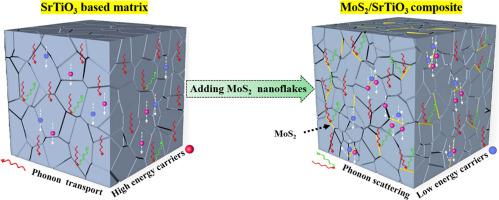Journal of Materiomics ( IF 9.4 ) Pub Date : 2022-02-12 , DOI: 10.1016/j.jmat.2022.02.002 Jilong Huang 1 , Yongping Liu 1 , Peng Yan 1 , Jie Gao 1 , Yuchi Fan 1 , Wan Jiang 1

|
As a semiconducting material with relatively low thermal conductivity, MoS2 nanoflake has the potential to serve as a modulator for optimizing the performance of thermoelectric (TE) materials. However, the low yield of MoS2 nanoflakes prepared by conventional methods has constrained the development of MoS2 optimized TE materials. We propose a mechanical exfoliation method for mass production of MoS2 nanoflakes using attrition mill. After mixed with La and Nb co-doped SrTiO3 (SLNT) powder, the MoS2/SLNT composites are fabricated by spark plasma sintering. It is found that the heterojunctions formed at MoS2/SLNT interfaces with proper band offset can effectively scatter the low-energy electrons, resulting in enhanced Seebeck coefficient without significantly undermining the electrical conductivity. The power factor of composites is improved when the MoS2 content is lower than 1.5 vol%. Meanwhile, the thermal conductivity of composites is significantly decreased due to the phonon scattering induced large thermal resistance at MoS2/SLNT interfaces, which is much higher than that in graphene embedded SrTiO3 composites. Consequently, a maximum ZT = 0.24 is obtained at 800 K in 1.5 vol% MoS2/SLNT composite, which is ∼26 % higher compared with pristine matrix. This work paves the way for application of TE materials modulated by transition metal dichalcogenides.
中文翻译:

机械剥离 MoS2 纳米薄片用于优化 SrTiO3 基陶瓷复合材料的热电性能
作为一种导热率相对较低的半导体材料,MoS 2纳米薄片具有作为优化热电(TE)材料性能的调节剂的潜力。然而,通过常规方法制备的MoS 2纳米薄片的低产率限制了MoS 2优化的TE材料的发展。我们提出了一种使用磨碎机大规模生产MoS 2纳米薄片的机械剥离方法。与La和Nb共掺杂的SrTiO 3 (SLNT)粉末混合后,通过放电等离子烧结制备MoS 2 /SLNT复合材料。发现在 MoS 2处形成的异质结/SLNT 界面具有适当的能带偏移可以有效地散射低能电子,从而提高塞贝克系数,而不会显着破坏电导率。当MoS 2含量低于1.5 vol%时,复合材料的功率因数得到改善。同时,由于声子散射导致MoS 2 /SLNT界面处的热阻大,复合材料的热导率显着降低,远高于嵌入石墨烯的SrTiO 3复合材料。因此,在 800 K 和 1.5 vol% MoS 2中获得最大 ZT = 0.24/SLNT 复合材料,比原始基质高 26%。这项工作为过渡金属二硫属化物调制的热电材料的应用铺平了道路。


























 京公网安备 11010802027423号
京公网安备 11010802027423号